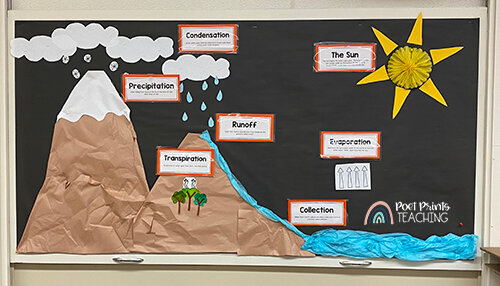Teaching The Water Cycle - 4 Creative Ideas
Integrating multiple subjects together is one of my favorite ways to teach. I look at almost any social studies or science unit and try to think about how I can weave my other subjects into it as well. It’s engaging for students and so convenient for me (hitting multiple learning outcomes at once… yes please!) Teaching the water cycle is one of my favorite science units because it naturally lends itself to so much cross-curricular integration. These water cycle activities are engaging for students and just so interesting to teach.
Teaching all about the water cycle in 2nd and 3rd grades.
Picture: A child stands in the rain under a rainbow umbrella.
Teach About Water with Picture Books
Before we even start looking at the science of water, I want my students to understand why we are studying water in the first place. From a guided-inquiry perspective, we are looking at the question Why is water important? I like to put this question on a bulletin board or make an anchor chart that we will refer to.
My favorite picture book to use as we explore this question is “One Well: The Story of Water on Earth” by Rochelle Strauss”. One Well is a beautifully illustrated non-fiction book that walks us through the different ways that water is used, consumed, and threatened on our planet. From the jacket:
“One Well” by Rochelle Strauss and
”Hope Springs” by Eric Walters are displayed on a table.
“Imagine for a moment that all the water on Earth came from just one well. This isn’t as strange as it sounds. All water on Earth is connected, so there really is just one source - one global well - from which we all draw our water. All living things depend on Earth’s One Well. Life would be impossible without it. But the water in the Earth’s well is threatened by our growing population and increased demands. What can we do to protect it? One Well answers this important question while telling the eye-opening story of water on Earth.”
For older students, Hope Springs, by Eric Walters, is a great picture book about limited access to water. Hope Springs is a story about Boniface, an orphan in Kenya during a season of drought. The book shines a light on the reality that many people in the world live in fear that there is not enough water for them to survive. Although the book deals with heavier content, the story is ultimately one of hope and kindness. It’s a great book to tie the water cycle, and water conservation, into a greater global context.
A Complete Water Cycle Unit is Here!
Looking for a whole unit? This complete water cycle unit features project-based learning, a guided inquiry project, directed lessons, small group projects, vocabulary games, and detailed teacher instructions all along the way.
No planning is needed, just print and that’s it!
Water on Earth Reading Passages and Comprehension
Don’t have a picture book that works? These differentiated reading passages all about water on earth a great way to introduce where water can be found on earth (and show students just how scarce freshwater is!)
“A Day Without Water” lapbook project is displayed on a table.
Imagine a Day Without Water
It’s so easy to take for granted the easy access we have to water, and how often we use it! Think about all of the times you have used water before you arrived at school. Did you brush your teeth? Wash your face? Grab a drink? Have a shower? Rinse your plate? Turn on the sprinklers on your lawn? This lapbook project asks students to stop and imagine that, for just one day, all of their taps ran completely dry! What would their day look like? What would be different?
After this writing project is complete, I like to use this as an opportunity to help students connect to others who may experience limited access to water on a daily basis. This is a great chance to talk about ways that, as a class, you may be able to help. (Can you fundraise together? Write cards? Collect supplies?)
Teach the Stages of the Water Cycle
This one might seem obvious, but when we are teaching the water cycle, we like to get hands-on with activities and classroom displays that help students to understand the stages of the water cycle.
This bulletin board uses the vocabulary cards from the Water Cycle unit to display the stages of the water cycle in a way that is clear for students to understand and provides a great reference for them to come back to as the science unit goes on. I also have also had students cut/glue the stages of the water cycle onto a fun worksheet (or complete it in a digital, Google Slides version) so that they are very familiar with the stages and the vocabulary!
This water cycle in a bag science experiment is such a fun and hands-on way to learn about the stages of the water cycle. I love how it uses cheap everyday materials that you probably already have in your classroom.
Make a Plan to Conserve Water
Water Cycle inquiry flipbook project.
Once students understand the water cycle and have explored our inquiry question why is water important, we like to end the unit with a small guided inquiry activity. This project puts students in the driver’s seat and asks them to ask the big questions about conserving water. Students get to choose their own focus and create a flipbook to address the problem that they see!
Have any more activities to go with our water cycle unit? I’d love to hear about them! Leave a comment below or connect with me on Instagram.







